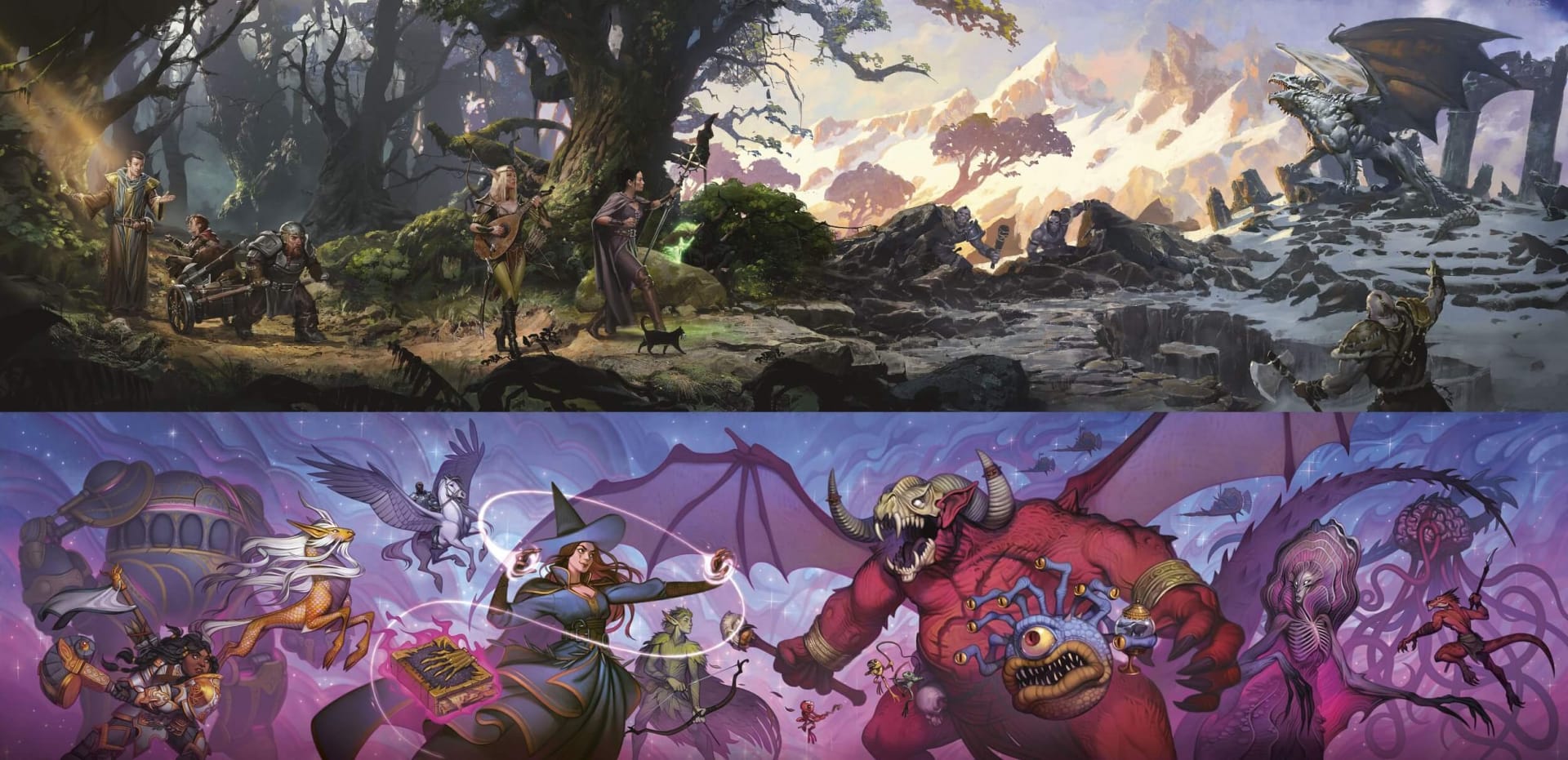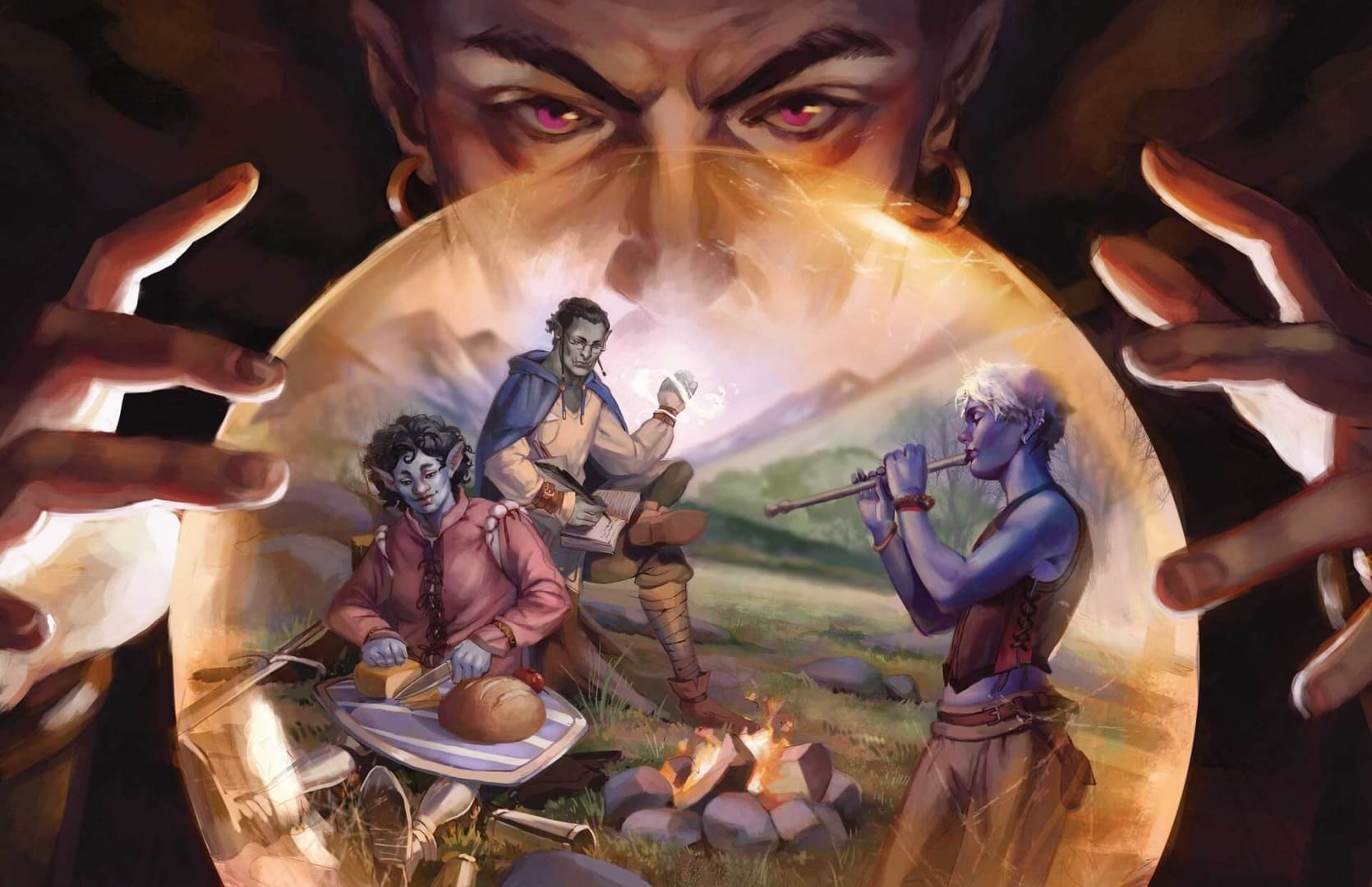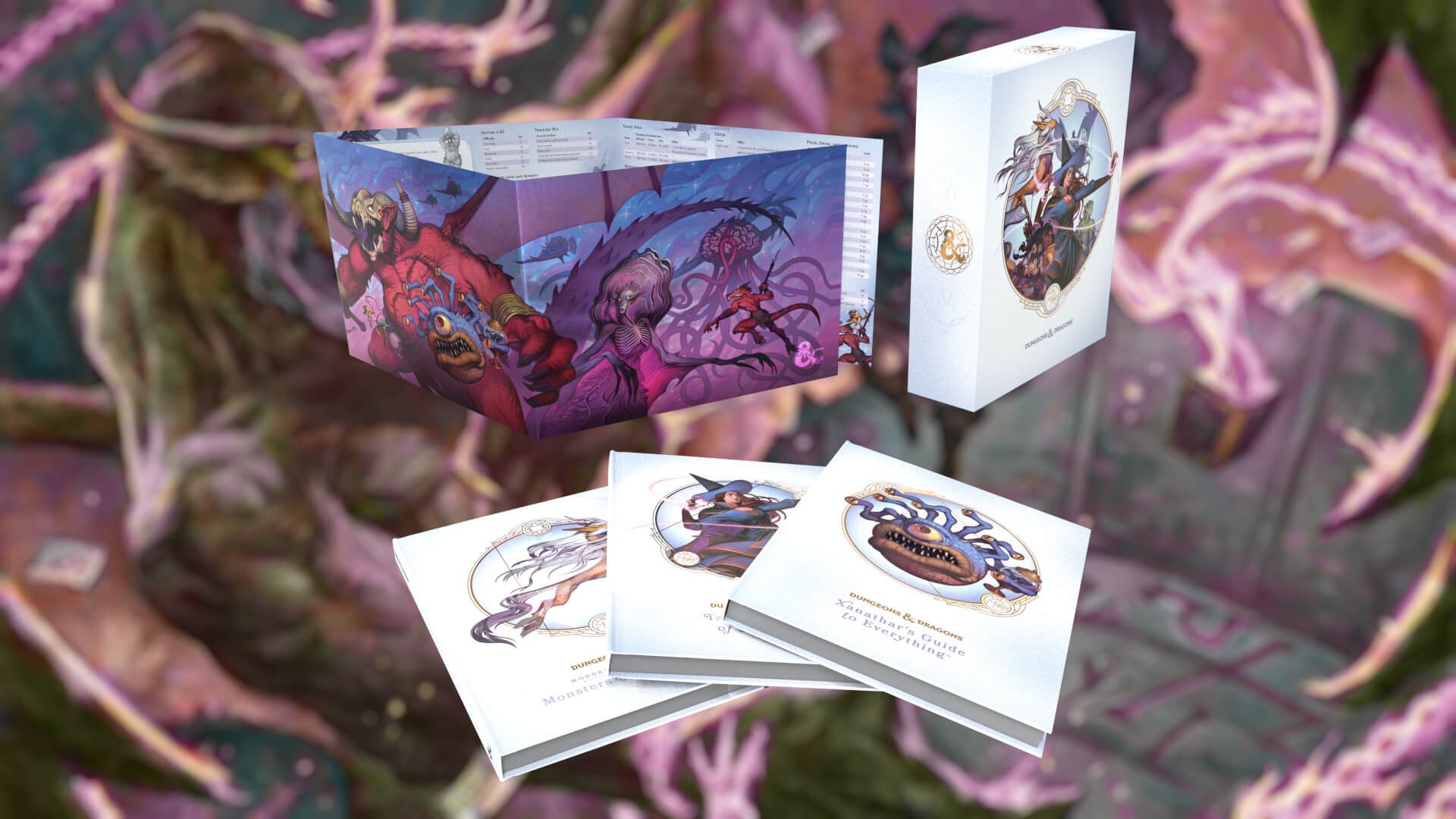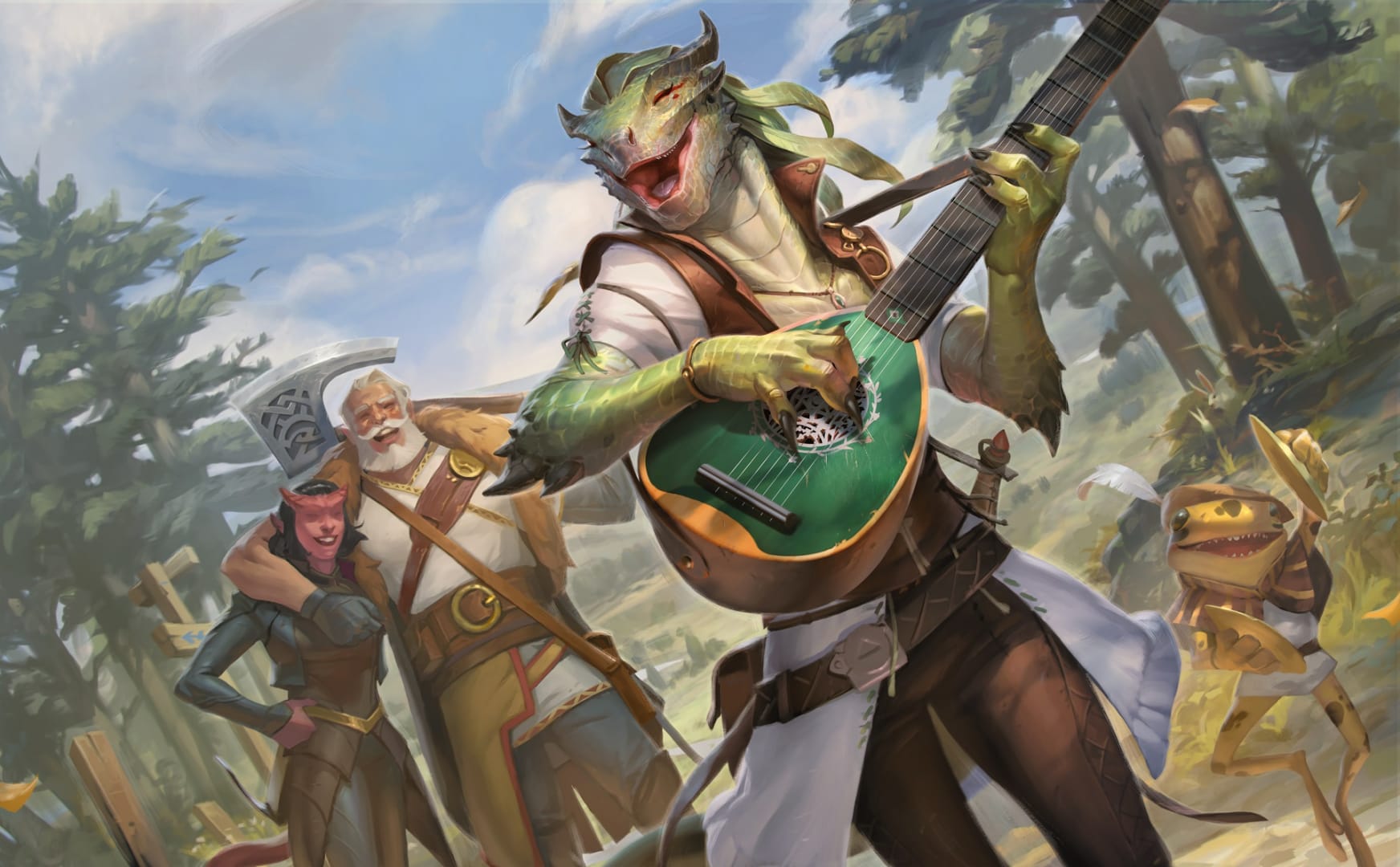Last week TechRaptor was lucky enough to have a chance to learn more about the upcoming Wizards of the Coast Dungeons & Dragons 5e products. The revised Gift Box Set comprised of Xanathar’s Guide to Everything, Tasha’s Cauldron of Everything, and the upcoming new book Mordenkainen Presents: Monsters of the Multiverse a collection of player races and monsters collected together from the different source and adventure books that have been released since D&D 5e launched in 2014.
This talk was moderated by Greg Tito, Senior Communications Manager for Wizards of the Coast, where he was accompanied by Liz Schuh of Brand Marketing at Wizards of the Coast as well as Jeremy Crawford the Principal Rule Designer of Dungeons & Dragons.
What is a part of the collection?
To start with Liz took us through the new Rules Expansion Gift set that will be available to preorder on January 25th. This slipcase will include Xanathar’s Guide to Everything, Tasha’s Cauldron of Everything, and Mordenkainen Presents: Monsters of the Multiverse. These editions of the games will feature the updated ruleset so if you already own the base edition of Xanathar’s Guide to Everything there will be a few changes that might be worth looking up. Also included within this slipcase is a new Dungeon Master (DM) screen showing off a variety of notable creatures from across the D&D Multiverse.

On top of the traditional version, there is also a white alt-art variant. The covers present their subject with a more minimalist feel. Compared to the dark-covered D&D books that have been released in the past like Strixhaven or The Wild Beyond the Witchlight the white look really pops. This alt art cover will also come with a different DM screen so be sure to take a look before you decide which you’re interested in purchasing. The alt-art was created by Joy Ang and it will be a limited edition release, Schuh warned those listening that once it’s gone it’s gone so get it while you can.
Schuh further explained that this collection was meant to release for the holiday season but unfortunately due to production schedules and difficulties they had to push it back to a January pre-order.
What can players expect to find within Mordenkainen Presents: Monsters of the Multiverse?
After announcing the standalone release of Mordenkainen Presents: Monsters of the Multiverse Schah handed the reins over to Jeremy Crawford to talk about what’s going on inside this new book.

Crawford began proudly describing the process that had started as a dream that has now manifested as this book. Since the release of the Players Handbook, Dungeon Masters’ Guide, and Monster Manual in 2014 with each new release new monsters and races have been continually added to D&D 5e. The barrier of entry to get access to all those stat blocks and Player races and sub-classes has been continually growing over the past 8 years. Monsters of the Multiverse is a collection of all of those races and monsters into one hefty tome. It includes content from Volos Guide to Monsters, Ebberon: Rising from the Last War, Princes of the Apocalypse, and even non-physically published content like The Tortle Package. Over 30 races that have been scattered over 8 years of books will be, for the first time, all together.
It wasn’t just collecting them all together that Crawford and his team wanted to do with this new revision, they also wanted to give everyone a “fresh coat of paint”. Some of these changes are the ones that Wizards of the Coast has been very public about and some were revealed here for the first time. Crawford explained that this “fresh coat of paint” was being applied for a number of reasons but wanted to break it down into what it would mean through the lens of Game Design, and what it means for Storytellers.
Changes in D&D 5e Races from a Game Design Perspective
After getting all of the races together and looking over their stats and added abilities it became clear that there were a number of races that just didn’t seem to be as powerful as others. While Crawford didn’t go into specifics about which races the team felt needed a bit more oomph he did explain that you’ll see a lot of the races getting more powerful. For those who are actively in a campaign, this might mean that your character gets a bit more going on, if you’re already one of the races that were deemed powerful enough though then be ready to celebrate with your party member.
Due to the publishing delays this was actually meant to be the first book to include the Fairy after realizing they never formalized this tiny player race. The Wild Beyond the Witchlight was being worked on at the same time so it was agreed that they’d find space for the Fairy, especially as it thematically matched so well.
The next big change is a bit harder to describe but it’s the removal, alteration, or addition of traits that are specific to the setting of the book, or a single corner of the multiverse. This has a lot of impact on storytelling but what it means mechanically is the removal of set Ability Scores, this is a change that was first introduced in Tasha’s Cauldron of Everything. Now when building each of these races you can give your character a +2 and +1 to two of your ability scores, or you can give a +1 to three different ability scores. Crawford explained that they didn’t like how much what class players wanted to enjoy would lock them into specific races, I mean who has ever heard of a half-orc rogue? Players would be shooting themselves in the foot if they didn’t have a Race that boosted the most important stats to their class. That is to say, if you still want a Dragonborn with a +2 to Strength and +1 to Charisma you’re more than welcome to. This change was aimed at freeing up player creativity as opposed to taking away something players enjoy.
Races might also get new Traits entirely, or simply have their traits renamed to something more generalized. An example of this is in the new Kobold update. Due to the listed history of the Kobolds in the Forgotten Realms, the Kobold here are described as “often bullied and enslaved by larger creatures – or, when they live on their own, they are constantly fearful of invasion and oppression.” This, and more, gives players an idea of what a Kobold is in the setting of the Forgotten Realms and leads to them having a racial trait like ‘Grovel, Cower, and Beg’. For the new Monsters of the Multiverse version without the specifics of the Forgotten Realms, this has now become ‘Draconic Cry’. As ‘Draconic Cry’ the ability has been sped up from an Action to a Bonus Action and has received the new use measurement from “once per short rest” to “proficiency bonus per short rest”. Whether you and your players want to interpret a draconic cry as a roar big enough for a Kobold to muster, or the D&D equivalent of crocodile tears to fit your play style is up to you though.

Changes in D&D 5e Races from a Storytelling Perspective
This leads perfectly into what Crawford explained was the purpose of making these changes as they fit the narrative. For a Forgotten Realms narrative, it might make sense for this Kobold to cower in fear or be crafty but the way that these books will present races is without any idea of cultural background. The same way that humans can be from anywhere, have any culture, and be raised to be a high-society Bard, or a Wizard struggling in city slums these changes will allow for that kind of storytelling freedom for any character you want to play.
Hobgoblins also got a tune-up in these regards. No longer is the book describing the militaristic lives that Hobgoblins lead in the Forgotten Realms. Instead the origins of their species, which is actually grounded in the Feywild, before they were kicked out. The Hobgoblin entry specifically describes the differences between some worlds where “hobgoblins form communities with deep ties to one another” or that in Ebberon “hobgoblin legions have emerged, with ranks of devoted soldiers famed for their unity.” Much like the Ability Scores if you want to keep this history for your hobgoblin going forward you’re more than welcome to, but it opens up for all kinds of different backstories for races you might not have ever considered playing before.
What puts the Monsters in Monsters of the Multiverse?
Holy Fire:
The war priest targets one creature it can see within 60 feet of it. The target must make a DC 15 Wisdom saving throw. On a failed save, the target takes 12 (2d8 + 3) radiant damage, and it is blinded until the start of the war priest’s next turn. On a successful save, the target takes half as much damage and isn’t blinded.
Monsters of the Multiverse does a good job collecting together 30+ races, but with 250+ monsters collected together from the different sources and adventure books of the past if you’re after something new to throw at your party here’s where you’re going to find it. Much like the tweaks that have been done to races you can expect the monsters to be less region-specific allowing for them to fit neater into your jigsaw puzzle of a campaign. The goal with Monsters of the Multiverse was also to streamline playing monsters for the DM completely reworking how they approached spellcasting monsters. Instead of getting a full list of spells and the different levels, those spells would be cast at the new format is getting told which spells are at will, which can be cast once a day each, twice a day each, etc. No longer will you need to be keeping an eye on a monster’s spell slots. Some entries even have completely new abilities added to them such as the War Priests ‘Holy Fire’.
Crawford explained that the thinking behind a lot of these changes and enhancements was “Can we make a monster even more like that monster?” trying to refine down its essence.
What makes a Combat Rating?
As well as new abilities a lot more monsters are going to be more dangerous. To combat concerns that higher Combat Rating (CR) monsters felt too underpowered the way the team determined what CR a monster was changed. In the past there was an optimal way to play a monster and as long as a DM was following that path then the monster would match that CR. Unfortunately, that meant in cases where it wasn’t played optimally the monster wouldn’t be reaching its full potential. To combat this monsters were redesigned with more ways to be played to their full capacity. None of these monsters CRs have changed in order to keep the creature compatible with the adventures where they might have originally been featured, but they’ve been boosted. This is another time where if you’re running a campaign it might be worth checking if there’s any changes to make encounters more interesting or exciting.

I did ask Crawford if there had ever been any ideas of including a “recommended” strategy to play for each of the monsters to best fit these higher CR monsters and while he did say it had been considered and even experimented with for 3e and 4e that they didn’t want it to be additional reading/planning for the DM to have to take on. By simplifying the stat block or making no ‘wrong’ option instead it would streamline the experience. Crawford did tease at the end that there were plans that they’re not ready to talk about yet related to DM guidance and that we should stay tuned.
While all of the monsters in this book are ones that have appeared in previously published content there are a few new stat blocks that aren’t entirely new monsters. For example when the Shadow Mastiff was first revealed a standard stat block was included, as well as a recommendation on how to tweak those stats to create a Shadow Mastiff Alpha. Now in Monsters of the Multiverse, there are separate stat blocks based on the recommendation. Other places where these recommendations of tweaks have been featured will also now come with their own standalone stat block.
Finishing out this excellent session it was also asked and clarified that all of these changes that are coming with Monsters of the Multiverse and the revisions to Tasha’s Cauldron of Everything and Xanathar’s Guide to Everything are all going to be forward compatible with the next edition of DnD that is scheduled to release in 2024.
The D&D Expanded Rules Gift Set will be available on store shelves January 25th along with the alt-art variant. The Mordenkainen Presents: Monsters of the Multiverse standalone release will be available May 17th 2022 in Physical and Digital editions. Preorders for Mordenkainen Presents: Monsters of the Multiverse begin today January 18th.
A Deep Dive Into Mordenkainen Presents: Monsters of the Multiverse and D&D 5e Gift Set
Source: Pinay Guide Blog
Walang komento:
Mag-post ng isang Komento